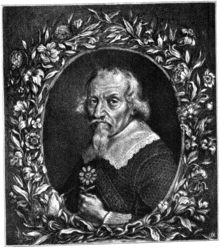Ludwig Jungermann
Ludwig Jungermann (born July 4, 1572 in Leipzig ; † June 7, 1653 there ) was a German botanist and doctor.
Live and act
His father Caspar Jungermann (1531–1606) was Professor of Law in Leipzig, his mother Ursula Camerarius (1539–1604) the daughter of the humanist Joachim Camerarius the Elder (1500–1574), a colleague and friend of Philipp Melanchthon . After studying medicine , Jungermann was initially in Nuremberg and from 1614 to 1625 was professor of anatomy and botany in Giessen . In 1616 he turned down a call to the renowned professorship for botany in London as successor to Matthias Lobelius , just as he had not accepted calls to the universities of Rostock and Rinteln before .
In Giessen he created the botanical garden ( Hortus medicus ). Today it is the oldest botanical garden in Germany, which is still in its original location. In 1625 he accepted a professorship for anatomy and botany at the University of Altdorf in Altdorf . There, too, he directed the Hortus medicus . Jungermann is the first botanist to publish local flowers. A Flora von Altdorf appeared in 1615. His Flora von Gießen, Cornucopiae Florae Giessensis and the Catalogus herbarum circa Giessam (both from 1623) have been lost to this day.
In addition to the two floras, he published the Hortus Eystettensis in Nuremberg together with Basilius Besler in 1613 . Jungermann was already known to his contemporaries as "vir botanicorum nemini secundus" . He is said to have once remarked that he would only get married if someone brought him a plant that he could not determine. He died celibate.
Honor taxon
Heinrich Bernhard Rupp named the liverwort genus Jungermannia from the Jungermanniaceae plant family in his honor . Carl von Linné later took over this name.
literature
- Ernst Wunschmann: Jungermann, Ludwig . In: Allgemeine Deutsche Biographie (ADB). Volume 14, Duncker & Humblot, Leipzig 1881, p. 711.
- Heinz Röhrich: Jungermann, Ludwig. In: New German Biography (NDB). Volume 10, Duncker & Humblot, Berlin 1974, ISBN 3-428-00191-5 , p. 683 f. ( Digitized version ).
Web links
Individual evidence
- ^ Heinrich Bernhard Rupp: Flora Jenensis . Frankfurt 1726, p. 294f.
- ^ Carl von Linné: Critica Botanica . Leiden 1737, p. 93
- ↑ Carl von Linné: Genera Plantarum . Leiden 1742, p. 506
| personal data | |
|---|---|
| SURNAME | Jungermann, Ludwig |
| BRIEF DESCRIPTION | German botanist and doctor |
| DATE OF BIRTH | 4th July 1572 |
| PLACE OF BIRTH | Leipzig |
| DATE OF DEATH | June 7, 1653 |
| Place of death | Leipzig |
